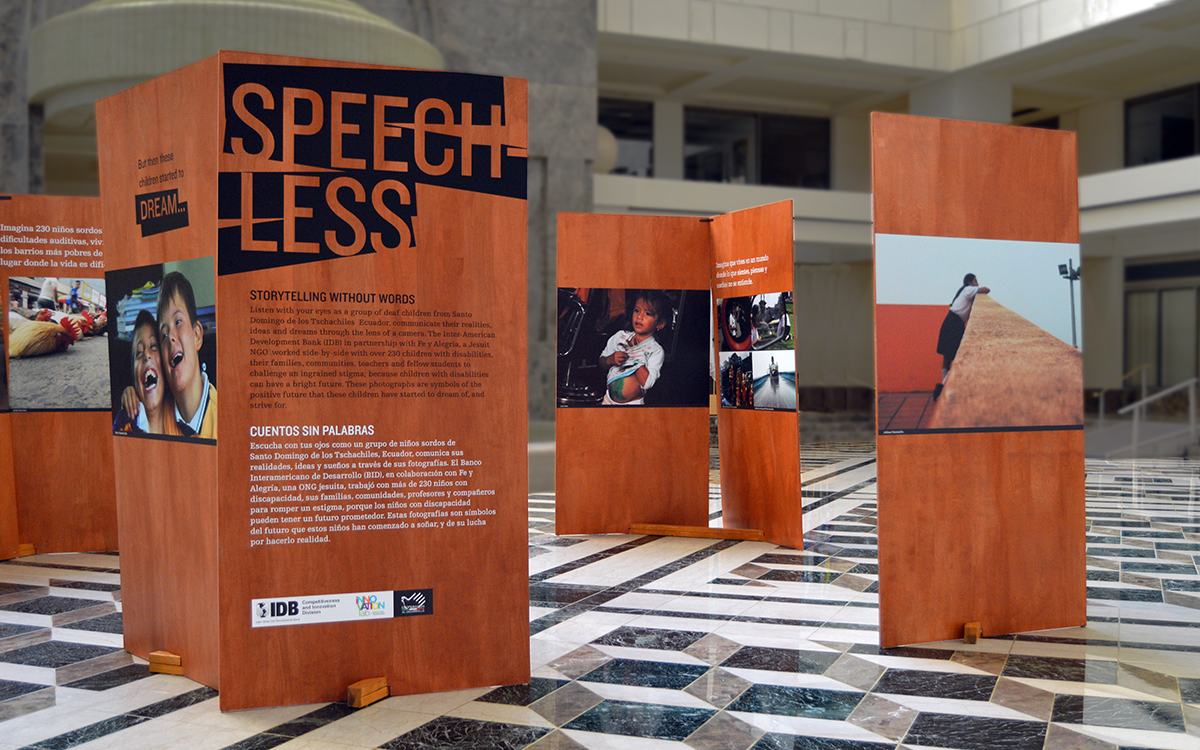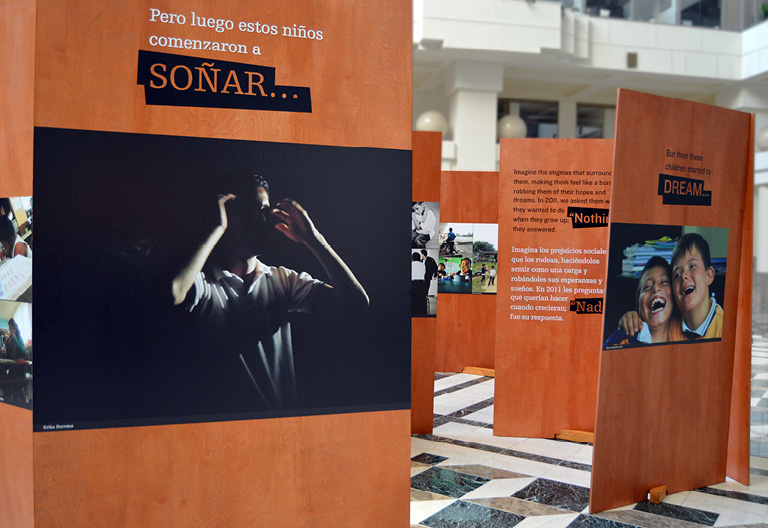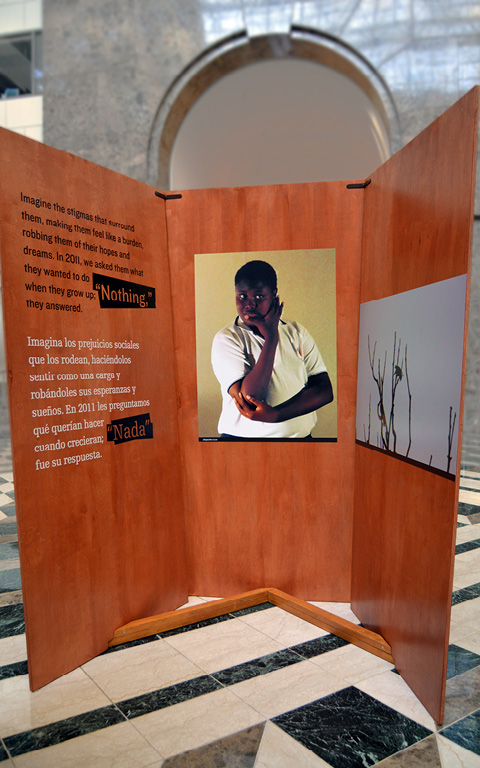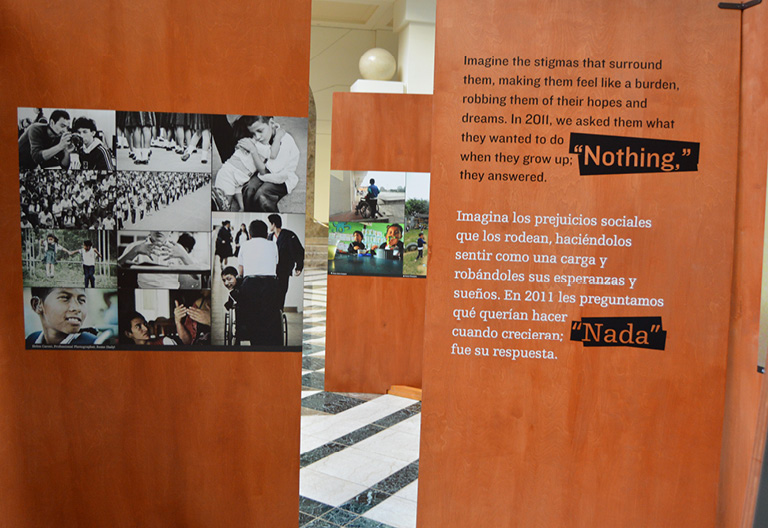Inter-American Development Bank Exhibit

Speechless is a traveling exhibit for the Inter-American Development Bank (IDB). The exhibit is the culmination of a social-inclusion project in Ecuador. The panels display the work of children with disabilities where technology has enabled them to improve their educational outlook.
The Inter-American Development Bank team worked with Fe y Alegría (a Jesuit NGO) to provide better education to children with disabilities through the use of Information and Communication Technologies1 (ICT), with the intention of establishing a model that can be replicated in other schools in Ecuador and then in other countries. This project promoted inclusive education among children with disabilities, but worked towards removing social stigmas, which in themselves hinder children from achieving their full potential

Design Goals The exhibit was located in the lobby of the IBD headquarters in Washington DC. The display serves two purposes: communicating the work of the IBD and also giving value to the art of children participating in the project.

Economy of means The exhibit was designed to be flat-packed and easily shipped to multiple destinations. It is also modular as to allow for adjustable configuration according to conditions of each location.

Innovative Design The tilted design of the panels were inspired from Richard Serra sculptures. The design creates a bold and unique identity for the exhibit, while also contributing editorial comment to the tenaciousness of the kids in the program.

Statement from IBD
Imagine 60 children with disabilities and without future …
…living in one of the poorest neighborhoods in Ecuador. Imagine a community marked by violence and a lack of education, where life is difficult for everyone. Within this community, these 60 children live with different kinds of disabilities. Imagine the social stigmas and prejudices that surround them, making them believe they are a burden, breaking their hopes and dreams. Imagine how their lives seem marked forever. Excluded forever. Imagine their lack of education, their absence of hope. Can you imagine a future for these children? In 2011 we asked them what do they wanted to do with their lives. “Nothing,” they said. …then suddenly these children started to dream… The IDB team worked side-by-side with these 60 children, their community, and their professors to change the idea that children with disabilities don’t have a future. How did we do it? …We put technology to work. And we measured its economic impact. In its basic form, our project set out to facilitate the access to education for 60 children with disabilities, in a school of Santo Domingo de los Tsachilas in Ecuador, through the use of technology. But more importantly, this project has positively impacted the sense of opportunity of children with disabilities, changing the perception of these children as a burden and increasing the likelihood that they attend college and yield positive economic returns.
The impact of this project has the potential to go beyond the school in Santo Domingo. There are at least 50 million people with disabilities living in Latin America and the Caribbean today, of which approximately 82% live in poverty. People with disabilities live in poverty because as children they did not have access to adequate education or were not able to study to their full potential, obstructing their possibilities of development. Between 70 and 80% of children with disabilities in the region do not attend school, and consequently 70% of people with disabilities are unemployed and/or excluded from the work force.
The cycle of poverty of children with disabilities and their families is vicious and seemingly impossible to break. But our project set out to break it.
With support from the Italian Trust Fund for Information and Communication Technology for Development, and in partnership with the Asociación Fe y Alegría Ecuador (FA) a Jesuit-run NGO, we provided solutions to help students with disabilities achieve their potential alongside other students by allowing them the educational possibilities they are entitled to. The IDB team worked with FA to provide better education to children with disabilities through the use of Information and Communication Technologies1 (ICT), with the intention of establishing a model that can be replicated in other schools in Ecuador and then in other countries. This project promoted inclusive education among children with disabilities, but worked towards removing social stigmas, which in themselves hinder children from achieving their full potential.
This project promoted inclusive education among children with disabilities, but worked towards removing social stigmas, which in themselves hinder children from achieving their full potential.
Category: Portfolio
Copyright © 2024 · All Rights Reserved · Museum Environments
· Log in
